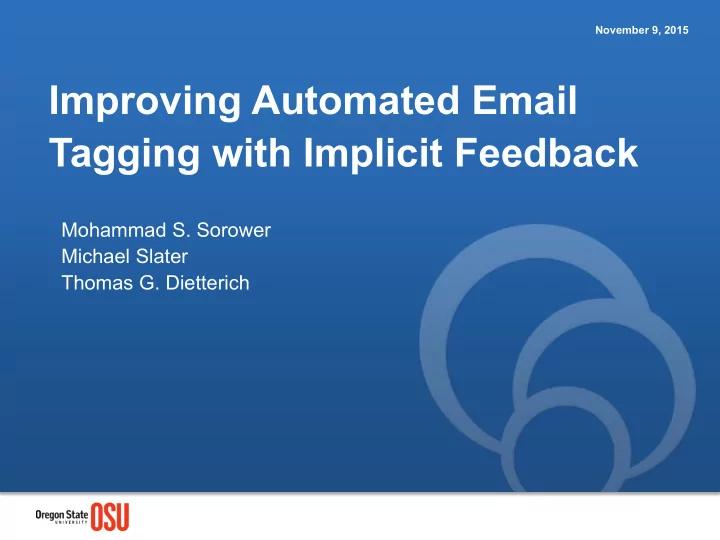

November 9, 2015 Improving Automated Email Tagging with Implicit Feedback Mohammad S. Sorower Michael Slater Thomas G. Dietterich
OUTLINE • Motivation • The Email Predictor • EP2 Instrumentation • Algorithms • Baseline Algorithms • Implicit Feedback Algorithms • The Lab-controlled User Study • Data set of Tagged Email Messages • Post-study Simulation • Results • Summary 2
MOTIVATION • Online Email Tagging: - user receives an email message - system predicts tags for the message - the email user interface shows the predicted tags - if a predicted tag is wrong: user may correct the tag (if so, the system receives training) - if a predicted tag is right: user does not have to do anything (the system never receives training) 3
MOTIVATION • Challenges: - learning algorithm never receives confirmation that its predictions are correct - the learning algorithm would benefit from positive feedback. • Survival Curve: - the more time a user spends on a message, the more likely that the user will notice tag errors and correct them. • Implicit Feedback! 4
THE EMAIL PREDICTOR (UI) 5
EP2 INSTRUMENTATION • Implicit Feedback Features: - message was opened and read in either the Outlook Explorer or the Outlook Inspector - user added or removed a tag on the message - user added or removed a flag from the message - user moved the message to a folder - user copied, replied, forwarded, or printed a message - user saved an attachment from the message 6
ALGORITHMS Baseline Algorithms: • No Implicit Feedback (NoIF) - never creates implicit feedback training examples - only trains on user corrections - standard behavior of EP ( Lower-bound on performance ) • Online - ignores all implicit feedback events - after making a prediction, creates training examples with the ground truth tags - provides perfect feedback to EP ( Upper-bound on performance ) 7
ALGORITHMS Implicit Feedback Algorithms • Simple Implicit Feedback (SIF) - when the user changes any tag immediately treats all remaining tags as correct • Implicit Feedback without SIF (IFwoSIF) - maintains a count of the total number of implicit feedback events - treats tag changes just like all other implicit feedback events - when this count exceeds a specified threshold, then it creates the implicit feedback training examples • Implicit Feedback with SIF (IFwSIF) - combines IFwoSIF and SIF 8
THE USER STUDY • Participants - 15 participants (1 dropped out) - only adult email users who receive 20 or more emails per day, regularly use tags, categories, labels, or folders • The Study Data - an email data set containing a total of 330 messages created from a variety of web sources - Train60, Test270 • The Study Sessions - three two-hour sessions on three separate days - 1 hour practice, 5 hours performing study tasks (reading emails, correct tags if necessary, follow instructions in the message) - user ground truth collected at the end 9
THE EMAIL DATA SET • Email life of a knowledge worker—a student in this case - a total of 330 messages - average number of tags per email message = 1.24 - messages with information, requests to send file, search online, save attachment, forward message etc. Tags %messages Economics 15 Entertainment 18 Gardening 19 Health 23 Math 17 Meeting/Event 31 10
POST-STUDY SIMULATION • The participants did not provide very much explicit feedback - mean percentage of messages for which they corrected tags was 16.3% • Solution: combine the observed implicit feedback events with simulated explicit feedback 11
POST-STUDY SIMULATION • Algorithm SampleEF ( user, TargetEF ) : Estimate the (fitted) probability, P(EF | totalIF) FOR every message, compute p i = P(EF( i ) | totalIF( i )) Compute the observed level of EF ( obs_EF ) in ‘ user ’ data IF obs_EF > TargetEF : DO:delete EF from the message (that has EF) with the smallest p i UNTIL obs_EF = TargetEF ELSE : DO:add EF to the message (that has no EF) with the largest p i UNTIL obs_EF = TargetEF 12
RESULTS • Implicit feedback captured during the study sessions of one participant. • The first session ends after message 66, and the second session ends after message 168. 13
RESULTS • Implicit Feedback Threshold Selection - a threshold exists such that the loss in accuracy of the resulting incorrect training is out-weighed by the gain of the resulting correct training examples 14
RESULTS • Cumulative Mistakes - plotted as a function of number of examples seen from the test data - SIF and IFwSIF algorithms have largely eliminated the gap between NoIF and Online 15
RESULTS • SIF produces the predominant share of the training examples • Additional examples added by implicit feedback have a substantial effect on further reducing prediction errors • IFwSIF receives 64% more training than NoIF, and 14% more training than SIF 16
RESULTS • Quality of the implicitly-confirmed training examples - at TargetEF 0.20, only 64% of the confirmed messages have correct tags - at TargetEF 0.80, only 74% of the confirmed messages have correct tags • Although implicit feedback is noisy, on balance the classifiers still benefited! 17
SUMMARY • Automated tagging of email with user-defined tags is possible • By instrumenting the UI, we can detect “implicit positive feedback” with reasonable accuracy • Incorporating implicit feedback into the classifier(s) improves the performance of the email predictor 18
QUESTIONS ? 19
SUMMARY • Highly-accurate tagging of email with user-defined tags is possible • By instrumenting the UI, we can detect “implicit positive feedback” with reasonable accuracy • Incorporating implicit feedback into the classifier(s) improves the performance of the email predictor 20
Recommend
More recommend